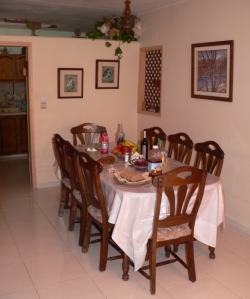òÂøÄéëÇú äÇùÑåÌìçÈï
Updated: 2013.09.29
 |
A•rikh•atꞋ ha-Shul•khânꞋ; "setting of the table"; refers to the Kha•sid•imꞋ fellowship meal table of the Tza•diqꞋ—their rebbe or, in the Nᵊtzâr•imꞋ case, Pâ•qidꞋ; especially of the ËrꞋëv Shab•âtꞋ and ËrꞋëv Khag meal tables.
The model for the Nᵊtzâr•imꞋ virtual counterpart is the Kha•sid•imꞋ custom of attendance by all tal•mid•imꞋ Nᵊtzâr•imꞋ at the meal table, led by the Tza•diqꞋ (Pâ•qidꞋ or, among more modern, European Kha•sid•imꞋ, their rëbbe), who distributes food and drink to those sharing the meal. This is similar in many respects to the holy meal shared by the Essenes.
In the spiritual counterpart, Tor•âhꞋ is the bread (representing all food) and the RuꞋakh ha-QoꞋdësh of fellowship is the îÇéÄí çÇéÌÄéí (running—literally "living"—water).
The meal is liberally supplemented, as the RuꞋakh ha-QoꞋdësh leads, by the a capella singing of Tei•mân•imꞋ zᵊmir•otꞋ spirituals (but not Yiddish songs, Yiddish being a product of German-European assimilation). The Tza•diqꞋ (the Pâ•qidꞋ or rebbe) personally blesses each attendee who partakes of the food and beverage he shares with them.
Like the Tei•mân•imꞋ, when gatherings are larger than a couple of families, women sit at a nearby separate table (no separating wall or curtain is necessary), where, with a bit of extra effort, they are able to communicate with the men when they wish. Like the Tei•mân•imꞋ at Ho•sha•nâꞋ Rab•âꞋ, and unlike some other traditions, Nᵊtzâr•imꞋ encourage women to sing along.
During the ËrꞋëv Shab•âtꞋ meal, the Tza•diqꞋ may teach Dᵊvar Tor•âhꞋ, spiritual passages from the Mid•râshꞋ, a point of Ha•lâkh•âhꞋ or Mᵊnor•atꞋ ha-Mâ•orꞋ (by Yi•tzᵊkhâqꞋ A•bu•hâvꞋ), relate parables or history, or share Judaic perspective on current events or politics.
Google+ registered author & publisher
Google+

